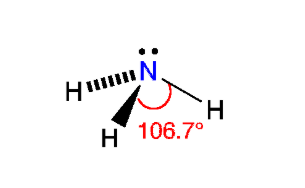
The shape of the $N{{H}_{3}}$ molecule is:
A. Tetrahedral
B. Trigonal Planar
C. Trigonal Pyramidal
D. Linear
Answer
589.5k+ views
Hint: The structure of the $N{{H}_{3}}$ molecule is given in accordance to the VSEPR theory of chemical bonding. Also, bear in mind its structure is heavily affected by the presence of a lone pair of electrons on the Nitrogen atom.
Step-by-Step Solution:
Let us first understand the VSEPR theory of chemical bonding before moving on to the particulars of the structure of the $N{{H}_{3}}$ molecule.
The Valence Shell Electron Pair Repulsion Theory abbreviated as VSEPR theory is based on the premise that there is a repulsion between the pairs of valence electrons in all atoms, and the atoms will always tend to arrange themselves in a manner in which this electron pair repulsion is minimalized. This arrangement of the atom determines the geometry of the resulting molecule.
With this knowledge in mind, let us now attempt to predict the structure of the $N{{H}_{3}}$ molecule.
Ammonia has 4 regions of electron density around the central nitrogen atom (3 bonds and one lone pair). These are arranged in a tetrahedral shape. The resulting molecular shape is trigonal pyramidal with H-N-H angles of 106.7°. The structure of the same is illustrated as follows:

Therefore, by analysing the above structure, we can safely conclude that the answer to this question is c) Trigonal Pyramidal.
Note: The influence of the lone pair of electrons is key to this structure as their presence changes the molecular structure of $N{{H}_{3}}$ from tetrahedral to trigonal pyramidal. Be very wary of this distinction.
Step-by-Step Solution:
Let us first understand the VSEPR theory of chemical bonding before moving on to the particulars of the structure of the $N{{H}_{3}}$ molecule.
The Valence Shell Electron Pair Repulsion Theory abbreviated as VSEPR theory is based on the premise that there is a repulsion between the pairs of valence electrons in all atoms, and the atoms will always tend to arrange themselves in a manner in which this electron pair repulsion is minimalized. This arrangement of the atom determines the geometry of the resulting molecule.
With this knowledge in mind, let us now attempt to predict the structure of the $N{{H}_{3}}$ molecule.
Ammonia has 4 regions of electron density around the central nitrogen atom (3 bonds and one lone pair). These are arranged in a tetrahedral shape. The resulting molecular shape is trigonal pyramidal with H-N-H angles of 106.7°. The structure of the same is illustrated as follows:

Therefore, by analysing the above structure, we can safely conclude that the answer to this question is c) Trigonal Pyramidal.
Note: The influence of the lone pair of electrons is key to this structure as their presence changes the molecular structure of $N{{H}_{3}}$ from tetrahedral to trigonal pyramidal. Be very wary of this distinction.
Recently Updated Pages
Why are manures considered better than fertilizers class 11 biology CBSE

Find the coordinates of the midpoint of the line segment class 11 maths CBSE

Distinguish between static friction limiting friction class 11 physics CBSE

The Chairman of the constituent Assembly was A Jawaharlal class 11 social science CBSE

The first National Commission on Labour NCL submitted class 11 social science CBSE

Number of all subshell of n + l 7 is A 4 B 5 C 6 D class 11 chemistry CBSE

Trending doubts
10 examples of friction in our daily life

One Metric ton is equal to kg A 10000 B 1000 C 100 class 11 physics CBSE

Difference Between Prokaryotic Cells and Eukaryotic Cells

1 Quintal is equal to a 110 kg b 10 kg c 100kg d 1000 class 11 physics CBSE

State the laws of reflection of light

Explain zero factorial class 11 maths CBSE




